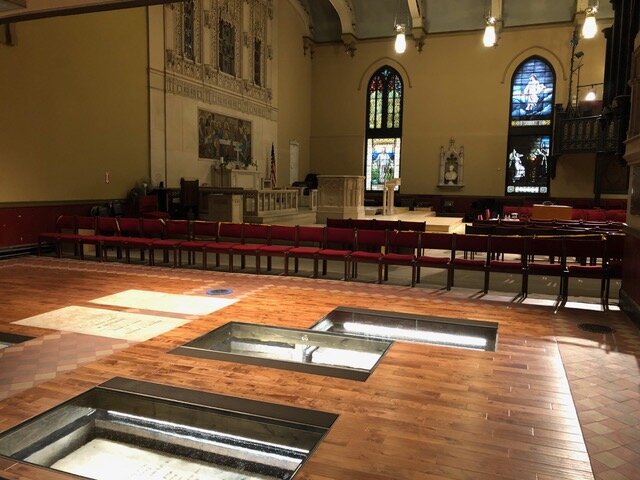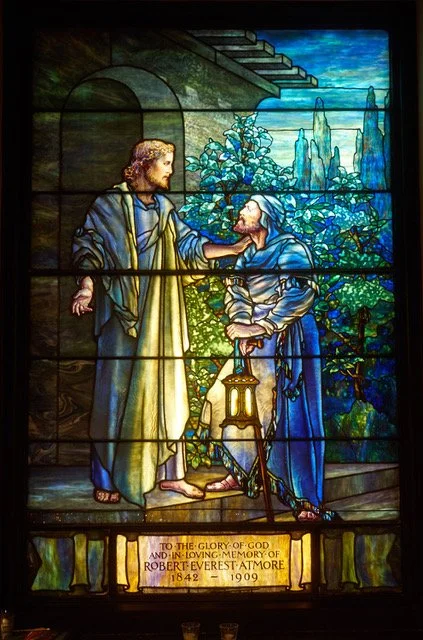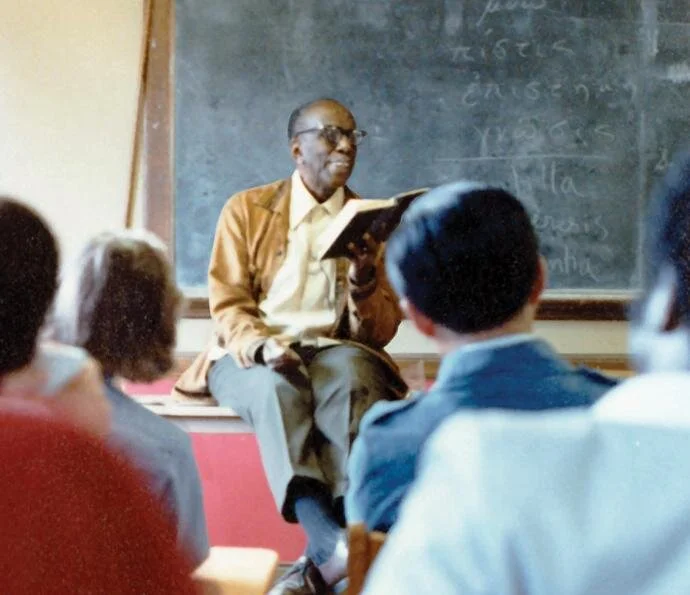Friday Reflection Part II: How has St. Stephen’s responded to the biblical call to live justly?
View from the Furness Burial Cloister
Sheltered in place at home, as this coronavirus rages on, I ponder St. Stephen’s responses over time to the Old Testament call to do justice, have kindness, and walk humbly with your God (Micah 6:8). There’s quite a variety!
Some appear quietly in the church’s everyday life: its hospitality. St. Stephen’s, like many parishes, embraced the disadvantaged of its neighborhood and beyond through schools, residences, clothing, activities. Its rectors introduced ambitious projects, like Dr. Worcester’s Farm (1898-1920), featured several weeks ago. Parishioners sought to engage with the inequality and distress suffered by others with kindness and humility.
Pursuits of the just way flash brightly, however, in exceptional and dramatic acts such as the one described last week, Dr. Ducachet’s rescue of the nearby Roman Catholic Bishop, Sisters of Charity, and orphans, under attack in the nativist riots of 1844. Even in a world rife with difference, open hostility and violence are an outrage, rendering risky, nonviolent action as admirably corrective.
Tomb slab of Hosea Johns Levis family during conservation
Other events engaged with moral compromise. Rather than tainting all, if we examine examples in light of living justly, with humility and compassion, we may see something else.
The Furness Burial Cloister is a telling example. The interment there of individuals touched by controversy might seem to compromise a parish that chose profit (burial fees) over morals. Instead, such burials in their midst constitute an especially significant collective act of acceptance and empathy. The entire Cloister then, is palpable witness to the parish’s compassion and embrace of kinship.
The family vault of Hosea Johns Levis, in the NW corner of the Cloister, is a case in point.
Levis, a founding vestryman and banker, ran into trouble during the prolonged Panic of 1837. He and the Schuylkill Bank of which he was president were accused of interstate bank fraud in 1839. The following year, Levis resigned and, shockingly, fled to France under an alias until he returned in 1842 to testify, with protection against prosecution. The ensuing case proved a sensational legal battle over years. Levis and his family continued to live quietly in Philadelphia, weighted by scandal. They lie in the Furness Burial Cloister with other parishioners, perhaps together humbled by the experience of crisis.
Another vault in the Furness Burial Cloister confronts the dark injustices that Martin Luther King, Jr. dreamed of leaving behind: slavery and racism.
Tomb slab for James and Ann Brown briefly exposed in 1989 before permanently uncovered for the Furness Burial Cloister project
In 1829, the congregation welcomed James and Ann Brown, held over in Philadelphia by illness and financial ruin, on their way to retirement in Kentucky from France, where he served as the head US minister. Ann died a year later (1830); distraught at losing her (according to his letters), James followed in 1835. They were buried together in St. Stephen’s churchyard, in a vault in the NE sector of what is now the Furness Burial Cloister. Lost in part through their banker’s financial problems, their livelihood depended on slave labor on their sugar plantation on the German Coast outside New Orleans. Three of their male slaves led the bloody failed uprising there in 1811. Histories of the rebellion portray Brown as an arrogant brute—unlike the polished diplomat of his long public career or the loving husband of his letters. All may be true. I don’t yet know their relationship to St. Stephen’s; they appear only in their funerals and burial there. As you see, their epitaph stresses their Southern identity and allegiance. Yet St. Stephen’s welcomed them in distress in life, and in rest within community in death. This too is an act of hospitality and compassion regardless of views of slavery and blacks (and they varied at St. Stephen’s).
Beyond the graves, a positive response to the Call, vis à vis slavery, emerged just before the Civil War. In 1859, Dr. Ducachet highlighted, in the Parish Registers, his baptism of five male black brothers newly arrived from slave-worked Virginia plantations and freed by their owner, congregant Dr. Wilson Cary Swann, who thus broke ranks with his powerful slave-owning Virginia family.
St. Stephen’s later collaborated with black Episcopal churches in town. In the early twentieth century, St. Stephen’s Atmore family was involved with the black community of South Philadelphia where the family owned and operated the first US mincemeat factory. I featured the family in an earlier post on their Tiffany Christ and Nicodemus memorial window. Robert E. Atmore, a famously private man, counts among the white founders in 1847 of the Church of the Crucifixion, a black Episcopal church of South Philadelphia. He served on its vestry and anonymously supported the church until his death in 1909. The two churches together built programs for the urban needy. Robert Atmore’s funeral at St. Stephen’s was jointly celebrated by St. Stephen’s rector, The Rev. Carl E. Grammer, and the admirable reformist rector of the Church of the Crucifixion, The Rev. Henry L. Phillips. What a powerful event, led by two commanding Episcopal rectors, for this modest, engaged parishioner.
With our challenging recent history to explore someday, how can we use these early examples, small and large, from our own community as guides?
—Suzanne Glover Lindsay, St. Stephen’s historian and curator
About Friday Reflections:
Every Friday, Father Peter and Suzanne Glover Lindsay share written reflections highlighting a particular theme. This week's Friday Reflection explores the topic Living Justly. Check out Friday Reflection Part I, where Father Peter discusses Martin Luther King, Jr. and Frederick Denison Maurice.












